A Rush Of Sweet Sap
deep musk & long dusk
Spring unfurling on the heath, 29 April 2023.
Every time I visit the heath - and that means most days - I see where the spring has tiptoed over last year’s dry mulch of bracken fronds, gorse roots, heather and moss, coaxing and teasing out the tightly furled fern heads and drawing them up to bask in the quickening sun. It actually brings a lump to my throat to witness the daily, unstoppable emergence of more and more of these little groups of heath-folk in all the thrusting vigour of youth.
I think that if I crouched down and stayed very still I would see the movement with my naked eye.
Perhaps I would hear the rasp of the old year’s residue, sighing softly as it yields to the new and the hopeful.
Maybe if I sniffed the air I would even smell the rush of sweet sap, swelling each stem as it pushes skyward, an uncoiling and a sacrament.
Sister, awake! Close not your eyes!
The day her bright light discloses
And the bright morning doth arise
Out of her bed of roses.
Therefore awake! Make haste I say
And let us without staying,
All in our gowns of green so gay
Into the Park a-maying!
Trad. British folk song
Full Moon in Scorpio
And so - already, it seems - the May full moon is with us, and this time there’s also a lunar penumbral eclipse. I knew the expression but hadn’t really stopped to consider what it meant so I had to look it up. A penumbral eclipse takes place when the moon travels through Earth’s penumbra, or the faint outer part of its shadow. (As an aside, don’t you just love the way the word penumbra feels when you say it?). The moon dims to the naked eye, but the difference is usually so faint that it can be difficult to notice unless you’re really looking out for it.
If you’re in the UK it won’t be visible at all, but of course it’s still happening! You have the best chance of observing the phenomenon in Asia, Australia, Africa, and eastern and central Europe. Interestingly, it will be the deepest penumbral eclipse since February 2017 and until September 2042, though I’m not sure how that is measured.
Eclipse or no eclipse, it’s time to look at the names for the May full moon. This moon is often referred to as the Flower Moon, originating as so many others do with the Algonquin peoples of North America. May’s moon was called the Month of Flowers by Jonathan Carver in his 1798 publication Travels Through the Interior Parts of North America in the Years 1766, 1767 and 1768, as a likely Dakota name.
The Cree people called this moon the Budding Moon, Leaf Budding Moon, Egg Moon or Frog Moon while to the Lakota and Dakota tribes it was the Planting Moon. The Oglata called it Moon of the Shedding Ponies which tells of the growing warmth of the spring sun.
Milk Moon, Bright Moon, Grass Moon, Hare Moon and Mothers’ Moon are all said to be Celtic or Old English names. Fiona Craven-Walker in 13 Moons gives Hare Moon, while in Liber Nox by Michael Howard we find the enchanting Merry Moon given for the May full moon.
How would you give a snapshot of this month in a moon name? Do any of these resonate when you look around you, or does something else sing out to you where you live? I’d be happy with Merry Moon or Hawthorn Moon but if I had to devise a name of my own I think I’d plump for Bluebell Moon, as there can’t be many sights that say ‘May’ more strongly than a hazy sea of blue stretching forever through the woods. How about you?
Bluebells in the Alder Carr on May’s Eve 2023
The wild garlic across from the alder carr is in full flower, 5 May 2023
The Meaning of May
May’s out: white, plump and plush
way-marker, sweet female unlucky spray;
tucked starry flowers, a million eyes
road-watching, field-guarding, a hilltop
presence, yearly more curved
with each twist of the earth, deep musk,
queen of long dusk, sharp secrets, she’ll
turn to blood in the hedge, rich burning
drops. Jets leap and scream
through a damaged sky; my skin
darkens in so much light. The tightening
drum. the hum of silage cutters
from a far field, muffled by bushy May.
Smother those savage thorns
in green and white: she will be beautiful.
In a changed world, still she draws you,
enters you, as woman to woman;
and you are not hurt, but healed and washed
clean, even now, wise-eyed, reborn.
Hilary Llewellyn-Williams, ‘Hawthorn (May 13 - June 9)’ from The Tree Calendar
Hawthorn in the lane, 4 May 2023
It may be May but here, at least, the hawthorn blossom isn’t yet out. Sooo close, though! As I mentioned in my last newsletter, the Lost Days of 1752 changed the calendar completely so that our first day of May is the equivalent of the 14th of the month when the Julian Calendar held sway and when most of the old sayings, rhymes and proverbs were coined. The may blossom in the lane will be out well before then; any day now, in fact!
And also, as Jan Blencowe says in her wise Substack Hedge Mystic:
May 1st isn't the date of astronomical Beltane. The celebration of Beltane on 1st May is a convenience of the modern calendar. The Beltane cross-quarter day, marking the halfway point between the spring equinox and summer solstice, is Friday, 5th May 2023, on the next full moon.
Which is today!
I do like the logic of celebrating Beltane/May Day midway between the astronomical grounding points of spring equinox and summer solstice, which means that the date will alter subtly from year to year. But we can go even further with this.
As Nigel G Pearson reminds us in Walking The Tides, the traditional timing of this festival was always linked to the flowering of the hawthorn tree rather than any fixed calendar date, and then only after other signs of the season had been felt and experienced. Obviously this would mean that people in different parts of the country or in other lands would be celebrating at varying times, making the celebration tie in more naturally with the flow of energies. Also, festivities to mark the beginning of summer traditionally took place throughout the month of May, and not just on one day.
The Anglo-Saxon name for the month was Thrimilci or Trimilchi, referring to the fact that cows needed to be milked more often due to the increasing abundance of fresh green grass. Butter, cheese and milk were therefore also more plentiful and it was traditional for people to take days off work during May to celebrate the coming of better times with games, dancing, singing and feasting. Many of these gatherings were known as Ales or Wakes, after the old term for staying up all night on the eve of a festival to watch the sun rise.
Around the Maypole
The one thing that was generally considered essential to have as the focus of the celebrations was the village maypole. This varied in height and decoration from place to place but was always keenly contested. Villages would even mount expeditions to steal their neighbours’ poles if they couldn’t get their own for any reason, or if they thought another one was better! Most often it was of birch or ash taken from the woods without the permission of the squire or farmer. Landowners tended to turn a benign eye to the practice though, even to the point of donating considerable sums for the entertainment.
One interesting thing that Nigel points out is that until relatively recently there was never any suggestion that the maypole was a phallic symbol, which he says was invented by Victorian folklorists seeking to backdate every traditional pastime to an idyllic pagan Golden Age, usually with a fertility theme. They were simply a focal point for the festivities and dancing during the May feasting and drinking. It’s possible that they originally served some kind of geomantic function, collecting the energy raised by the dancing and distributing it into the fields. Apparently the poles weren’t even decked with ribbons that would be woven and wound by the dancers. This is another Victorian addition although they were often covered with greenery and garlands.
The may fairs (think of Mayfair in London!) could be rowdy and bawdy affairs as you can well imagine, and were disapproved of by reformers long before they were banned altogether during the Interregnum in England under Oliver Cromwell. Needless to say, they were brought back with great joy after the Restoration.
One of my most treasured childhood memories is of dancing around the maypole at the appropriate time of year when I was in the Infants at Primary School. Like other special things that only happened in a certain season I looked forward to it excitedly. The pole would be brought out from the cupboard and erected on its stand in our school hall, its multicoloured ribbons twirling unfurled. The girls and boys would take alternate ribbons and skip in and out as directed by the teacher, theoretically creating a beautiful woven ‘coat of many colours’. More often it was a tangled mess. Our teacher might have minded but I certainly didn’t. It was ritual and I loved it to my core.
During a visit to the village primary school my children were about to begin attending, I noticed the unmistakable form of a toppled maypole in the cupboard of the school hall. ‘The children used to dance around the maypole’, explained the headteacher, ‘but when I was appointed I stopped the practice as I thought it completely inappropriate for a Church of England primary school.’ Now, if you travel around the countryside you will see that many county primary schools are designated CEVA (Church of England Voluntary Aided). It’s a common phenomenon, dating back to when the provision of education was, indeed, voluntary.
My children’s school was a very rural one, and many of the parents worked on the land in some capacity. I love to imagine that headteacher finding herself in a timeslip, watching in horror as their medieval churchgoing ancestors revelled around the maypole on the village green.
The maypole dancing at my primary school was a tame affair compared to this :)
Even the oaks are shaking out their green leaves now.
Greenwood Lovers’ Berry Breakfast
Be wary of lovers who come from the greenwood
Dissolved in the light of a full summer bloom
They may draw you like deer to the glade and the spinney
Held fast by the charm of their glittering tunes
* * *
Thin fingers are pinching from thorn bush and briar
The haunts of the elvish are slipping away
The dancers are tripping back into the shadows
Wish not for a greening wood lover to stay
Carolyn Hillyer, Be Wary Of Lovers Who Come From The Greenwood
Home from the greenwood for a sweet earthy breakfast full of forest flavours
The sweet bells and silver bright whistles of the Fair Folk shimmer and glimmer enticingly at Maytide. Who knows where we may find ourselves as we’re fairy-led deeper and deeper into the forest?
There’s the fairy-lover on the one hand, and then there’s the Greenwood Marriage where you and the one you love might steal away to go ‘a-maying’, staying out in the woods all night conjuring Summer in.
Oh do not tell the priest our plight / for he would call it a sin / but we have been out in the woods all night / a-conjuring Summer in - A Tree Song by Rudyard Kipling, arranged and renamed Oak, Ash and Thorn by Peter Bellamy.
In either case, the morning after you will need a sweet, fortifying breakfast full of forest flavours to remind you of the dewy enchantment of the night before.
This recipe serves two - of course. But if your elfin consort has melted away you can always halve the quantities, or pop half into the fridge for breakfast the following day.
Two handfuls porridge oats
Four small handfuls cashew nuts
1 banana
Two good handfuls frozen berries. Foraged wild strawberries and blackberries would be perfect, but supermarket Fruits of the Forest will do! If using fresh berries I suggest slicing and freezing the banana instead. It’s good to have one frozen element.
Milk or any plant-based milk to give the consistency you like
2 tbsp tahini paste
Optional - 1 tbsp each - some or all of the following: chia seeds, hemp powder, baobab powder, acai powder.
Place the oats and cashews in a blender with about 300ml milk to start with (you can adjust the consistency later). Leave to soak for a few minutes if you can, especially if the blender isn’t very powerful, as this will soften the cashews. Add everything else and blend well until silky smooth. Serve as it is, or with coconut or other yogurt on top. I like a sprinkle of milled flax seed on mine.
I hope you’ll enjoy it! If you try the recipe, let me know what you think.
At the edge of Acorn Wood - the heath - new bracken exploding through the old, 29 April 2023
Until next time at the new moon,
With love, Imogen x
Full moon tonight at Happisburgh on the cliff top, 5 May 2023

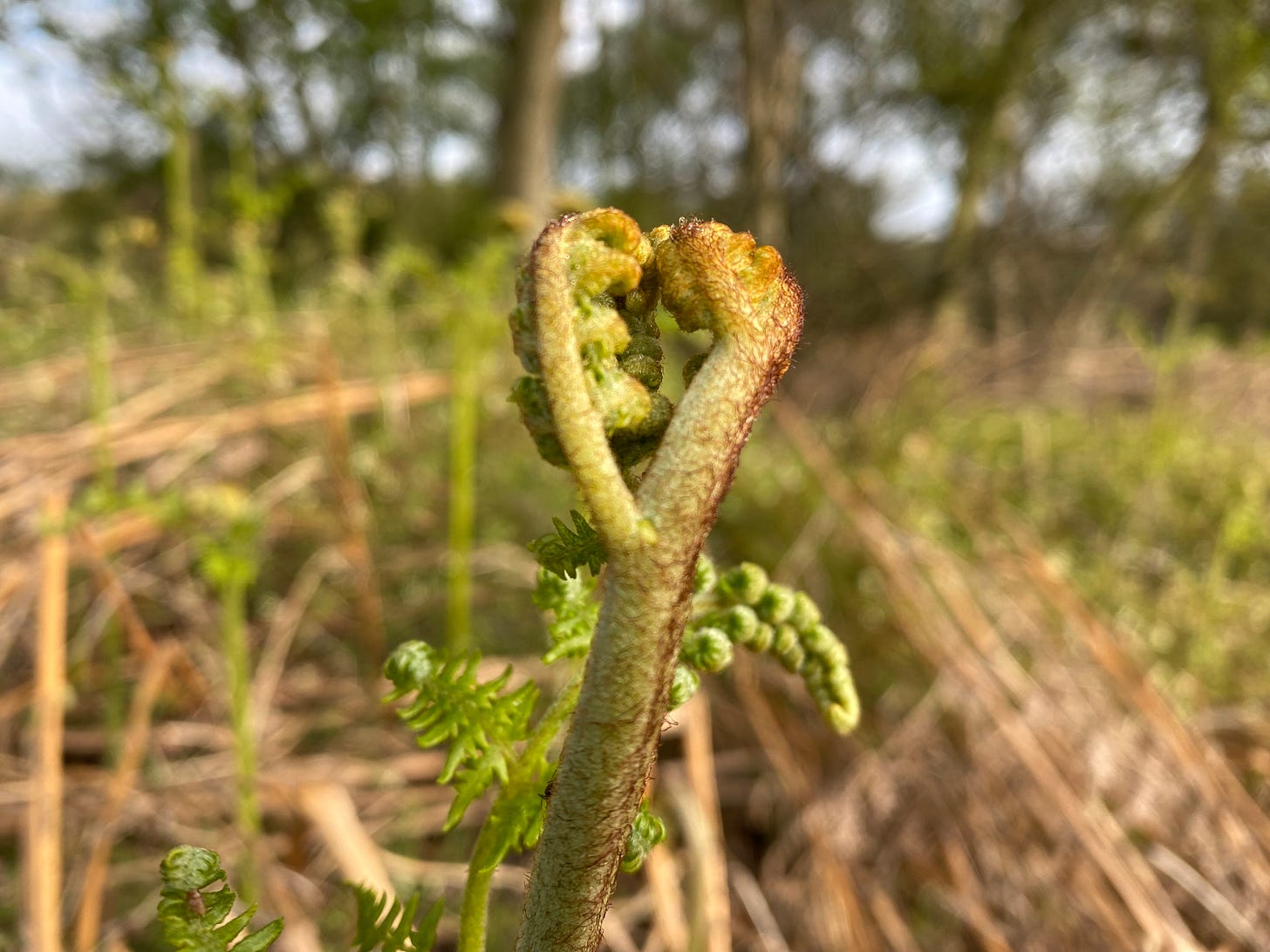
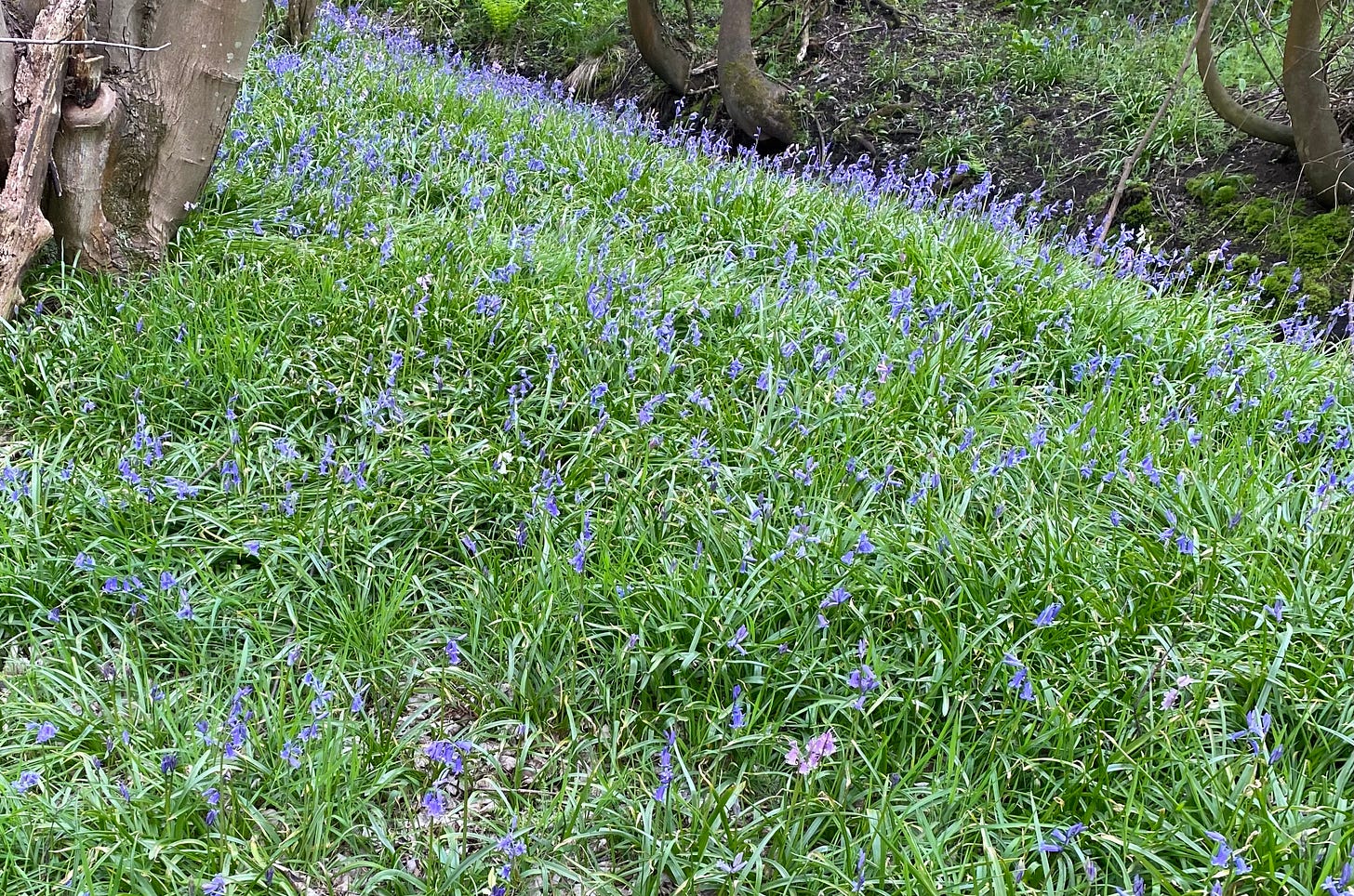

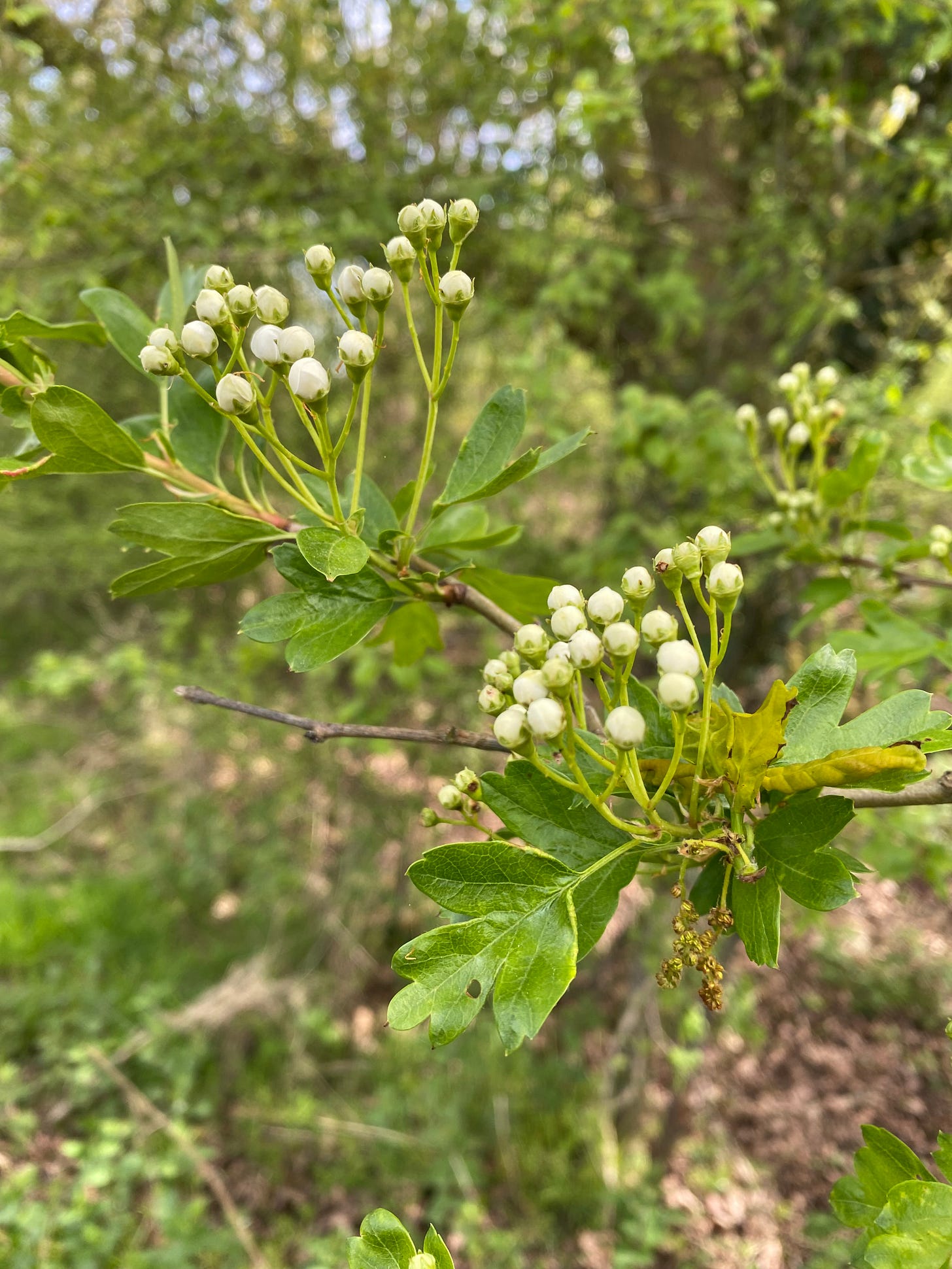
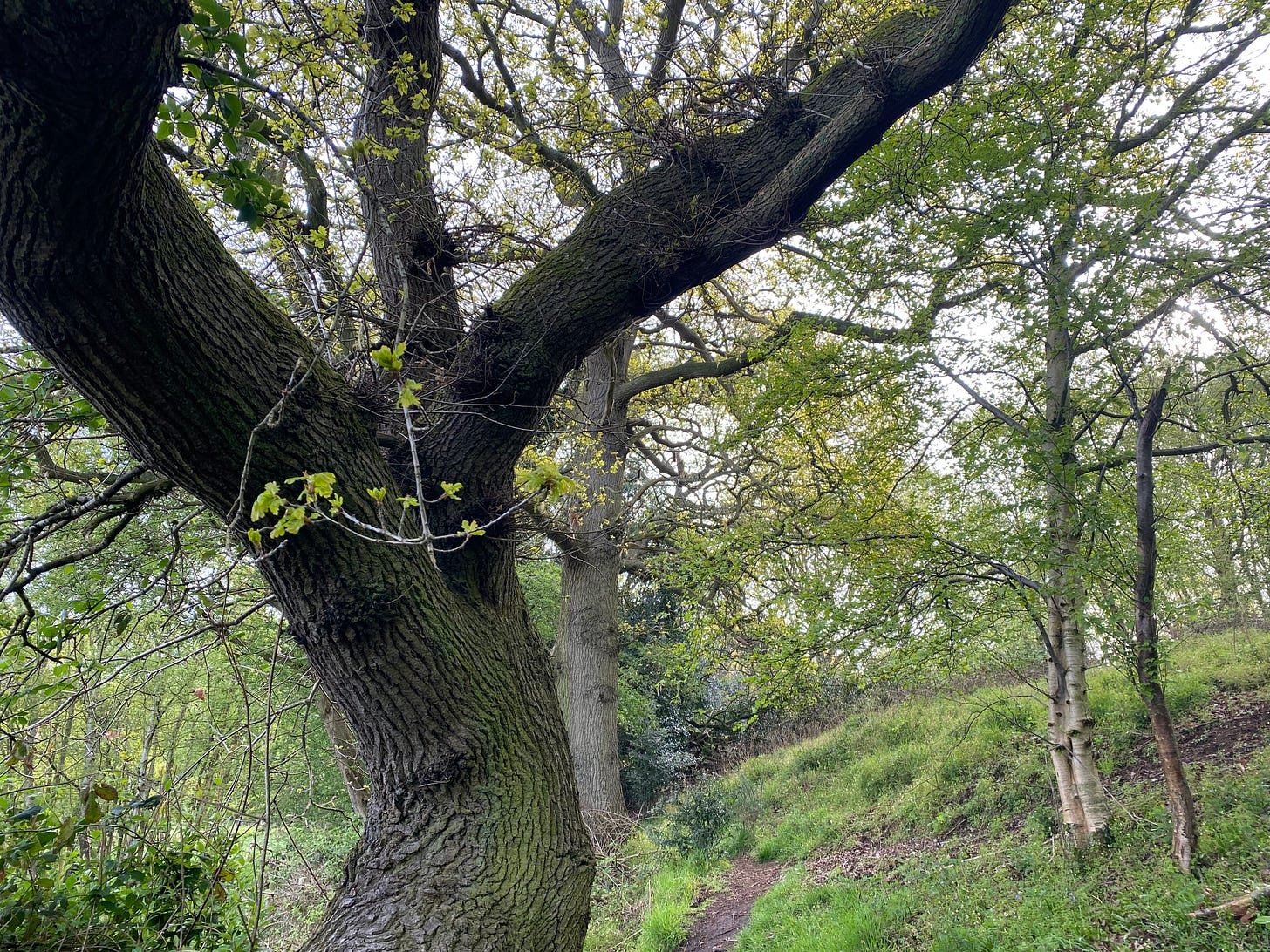

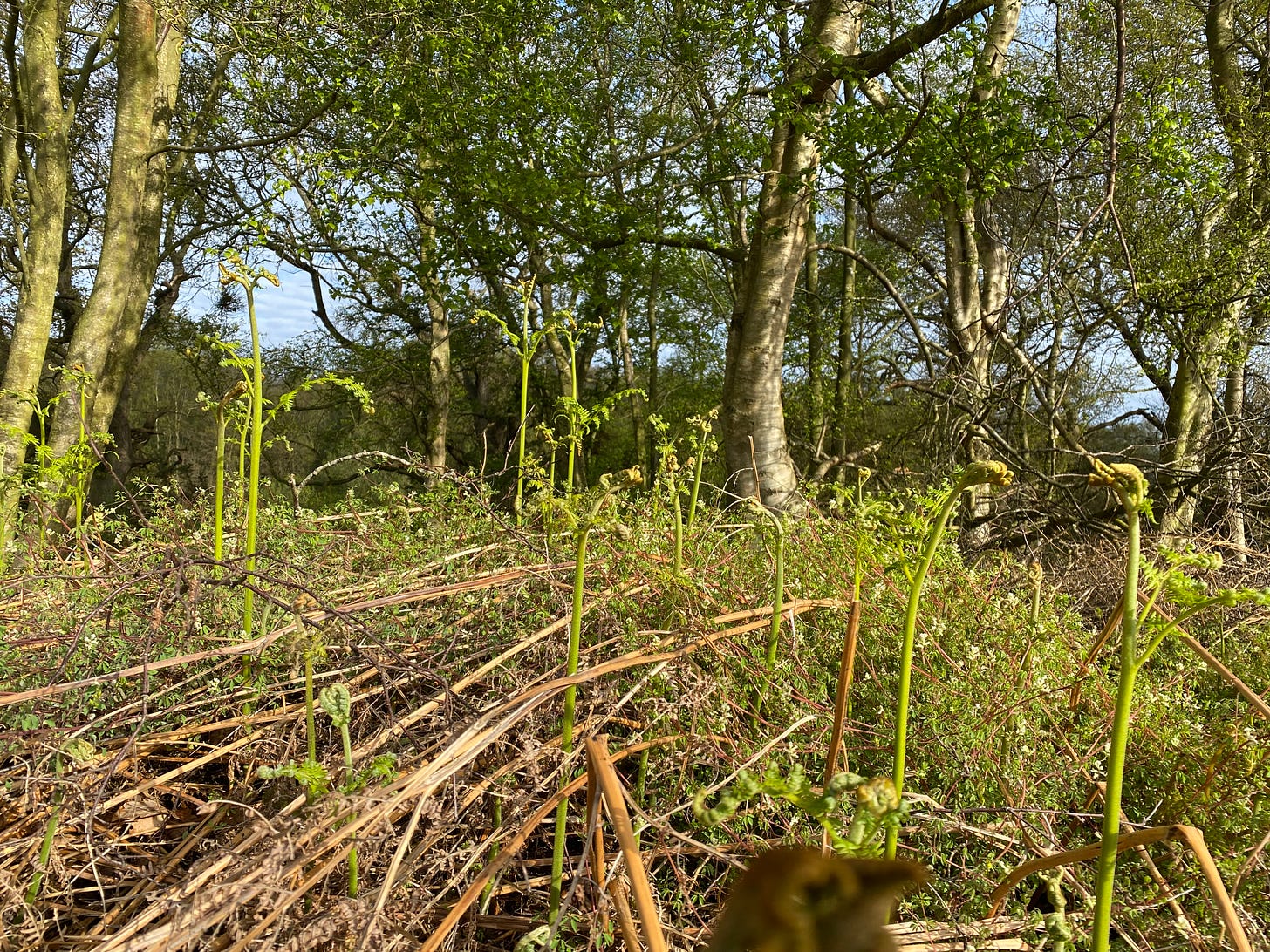

The moon is not yet visible yet tonight as I write this but I would call it The Frog Moon or ( the Cautious*) Planting Moon.
I love to hear of and imagine the dreamy bluebell woods and Maypoles but sadly we do not have either where I am.
There is almost a sweet imagined nostalgia - as if there’s a deep memory in the bones that one can’t quite grasp a firm hold of.
In fact I like the idea of a “floating” Beltane or May Day as the climate where I am is not in synch with these festival days and indeed the Indigenous People’s marking of the year just make more sense, as does the budding or flowering of a local plant to mark the arrival of spring or celebration.
*Gardening by the Moon, this is only a time for planting hardy root veg. The safe planting is closer to the 20th.
Your smoothie bowl sounds delicious.
Sweet May - harbinger of rebirth, renewal, and possibility! Thank you for celebrating its beauty - and that moon picture! Grandmother looking so elegant and mysterious above the water. Blessed Be!